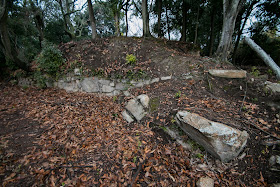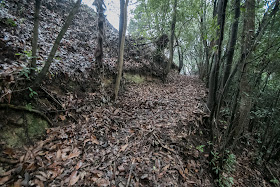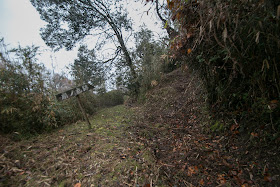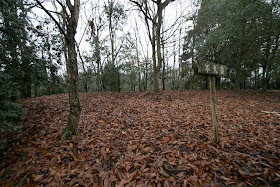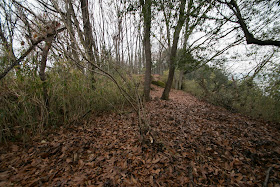Takayama Castle (Aki)
-Intellectual pillar of Mouri clan (1) take over and restructuring-
Overview
Name: Takayama castle (Takayama-jo)
Alias: Tsumatakayama-jo (Tsumatakayama castle)
Place: Takasaka-cho Mihara city, Hiroshima
Location: 34.41886679423088, 132.9856715730649
Type: Mountain Castle
Built: 14th century
Remaining remnants: Stone walls and clay walls
Title:
Takayama castle (高山城) is built over Tsumatakayama mountain, one of about 150 meter height from hillside at the side of Nuta-gawa river, about 10 kilometer west of current Mihara city central. At the opposite of the river there is Niitakayama mountain of same height, and these two mountain stand like a pillar of the gate.
Mihara area was a border of Aki province (western part of Hiroshima prefecture) and Bingo province (western part of Bingo province), and castle site is an important place of communication where is the crossing point of Nuta-gawa river, and junction of eastward inland and coast roads from Onomichi area, westward road to Hiroshima area and northward road toward Miyoshi basin.
Additionally, now disappeared by land reclamation but formerly there was a large inlet of over 10 kilometer from current river mouth to just the below of the castle. Formerly there was a good port at castle town, and worked as a starting point of marine transportation across Seto-Naikai sea along with the line of Geiyo Shoto island.
Precise year is unknown but Aki Takayama castle might be built by local lord Kobayakawa clan in 14th century. Kobayakawa clan was a direct descendant of Sanehira Dohi (?-1191?), who contributed to the establishment of Kamakura Shogunate supporting its founder Yoritomo Minamoto (1147-1199).
Just after his raise Yoritomo once suffered severe defeat at the battle of Ishibashiyama occurred at current Odawara city before Taira clan army, then hided themselves in the cave then secretly escaped to Awa province. Sanehira accompanied this and encouraged Yoritomo, then ordered the ship for escape.
Yoritomo deeply trusted Sanehira then Sanehira served as the commander of main army at the battle of Ichinotani. Later Sanehira became of the regional commander of Chugoku region, and governed current Okayama prefecture and Hiroshima prefecture.
After the fall of Taira clan, Dohi clan seized Nuta area where is the downstream of Nuta-gawa river as their manor, where was formerly held by Nuta clan which belonged to Taira clan and ruined. But the main stream of Dohi clan disappeared by political conflicts in the Shogunate, and the family moved to Nuta area only survived then changed their surname to Kobayakawa clan.
As there are two flat areas that mean Nuta area along with Nuta-gawa river and Takehara area formed by Kamo-gawa river, Kobayakawa clan became separated into two family, Nuta Kobayakawa clan at Nuta area and Takehara Kobayakawa clan at Takehara area.
At the fall of Kamakura Shogunate two families once belong to other side, but Kobayakawa clan could survive as the local lord of Aki province. In the middle part of Muromachi era, Kobayakawa clan became involved in marine transportation at Seto-Naikai sea, and held their own navy and expanded the north part of Geiyo Shoto island. Around this time Takayama castle was expanded along with the development of Kobayakawa clan.
Tsumatakayama mountain has two lines of ridges at north and south of hilltop area. Norrthern ridge is the core part of the castle, which consists of Kitanomaru area, Secondary area, central area and Oginomaru area. Central area is an oblong shaped area of 80 meter long and 20 meter wide, which had partial remnant of stone wall build on each line.
Secondary area and Kitanomaru area are the same size as central area, and both of them also have partial remnant of stone wall. The northern line of the areas which is connected to outside of the castle by land was decorated by line of stone walls. Areas of this part are comparatively large and might have large buildings as residential area.
On the other hand, south ridge at the opposite of the valley called riding space has the line of smaller areas. This ridge faces the inlet and castle town thus might be the originally developed area and might be kept the inner castle. Total size of the castle is about 600 meter long and 400 meter wide, and its size and structure is worthy as the main base of major local lord.
In the former half of 15th century, Nuta Kobayakawa clan approached to the Shogunate and expanded their power by domestic and foreign trade. But the power of Shogunate declined and lost after the battle of Onin from 1467 to 1478, in which two family of Kobayakawa clan belonged to different side again.
Since the end of 16th century, Ouchi clan which was the warlord of Suo and Nagato province (Yamaguchi prefecture) became the strongest warlord of western half of Japan being supported by its monopoly of foreign trade toward the continent. In the beginning of 16th century Ouchi clan once marched to Kyoto city and established their side government.
Takehara Kobayakawa clan followed to Ouchi clan as Takehara area was at the next of Saijo basin which was the front base of Ouchi clan, and became equal to Nuta Kobayakawa clan which lost the power by internal conflicts. In 1512 local lords of Aki province made alliance under Mouri clan, the local lord of Yoshida Koriyama castle (Hiroshima prefecture), Takehara Kobayakawa clan participated in that alliance.
In the beginning of 16th century, Amago clan which united Izumo province (eastern half of Shimane prefecture) under intelligent leader Tsunehisa Amago (1458-1541) started its aggressive expansion toward east and south. Amago clan which captured north part of Bingo province continued its expansion toward south, and territory of Kobayakawa clan became the frontline of Amago clan and Ouchi clan.
Among this severe situation, Nuta Kobayakawa clan lost three consecutive leaders in youth by illness or battle. In 1540, Amago clan attacked Yoshida Koriyama castle, and Takehara Kobayakawa clan turned to Amago clan. But Amago clan failed to capture the castle and suffered severe defeat by reinforcement army of Ouchi clan.
Under this situation Takayama castle was seized by Ouchi clan, and the leader of Nuta Kobayakawa clan was confiscated. Next year this time Ouchi clan attacked Gassan Toda castle (Shimane prefecture), the main base of Amago clan and also failed, thus Amago clan recovered their power. Amago clan attacked Takayama castle but Nuta Kobayakawa clan barely rejected it.
Around this time, deposition of the sands at the inlet expanded rice field of the area but the function of the port significantly declined then moved to the downstream of the river. Loss of economic interest further worsened the situation of Nuta Kobayakawa clan. At the same time, Takehara Kobayakawa clan also lost its leader in the battle without successor. Kobayakawa clan was forced to the corner to disappear.
Looking at this situation, Motonari Mouri (1497-1571) who gradually increased their power and Ouchi clan hoped Kobayakawa clan to stay at their side, then sent his third son Takakage Kobayakawa (1533-1597) as the leader of Kobayakawa clan in 1543. Originally the niece of Motonari married with the person of Takehara Kobayakawa clan and there was a connection between two clans.
Furthermore, Ouchi clan and important retainers of Kobayakawa clan hoped Takakage Kobayakawa also became the leader of Nuta Kobayakawa clan as the current leader of Nuta Kobayakawa clan was illness and difficult to command the army. In 1550, leader of Nuta Kobayakawa clan was forced to retire and Takakage also became the leader of Nuta Kobayakawa clan then united two families. Former leader survived but his supporters were purged.
Next year, Takakage Kobayakawa who took over two Kobayakawa clans abolished Takayama castle and newly built Niitakayama castle at the opposite of Nuta-gawa river for new main base. Same as the merger of the companies at current era, it was necessary to change the atmosphere of the clan, and had to avoid the image of absorption of Takehara Kobayakawa clan by Nuta Kobayakawa clan.
Practically, the structure of Aki Takayama castle was easy to divide by the center, and north part which is captured by enemy might be used as a good base to attack core part of the castle. Contrary to Tsumatakayama mountain, Niitakayama mountain is smaller but easy to defense by limiting its approach route, and it had to show the down grade from the main base of independent warlord to the retainer of Mouri clan, even if it was the one of two top of Mouri clan.
However, after its abolish some fort might be kept at castle site as Castle site is close to Niitakayama castle and can easily look inside of the castle. Along with the increase of his power with the expansion of Mouri clan, Takakage might use whole part of corridor between river mouth to castle site as his main base.
Now no building remains but structure of the castle still remain on the mountain. From castle site the valley of Nuta-gawa river formerly was an inlet and the shape of Niitakayama mountain is well seen. Two castle stands at the both side of the river shows severance and continuation of Kobayakawa clan, as a result of take over and restructuring.
Continue to Part 2
20 minutes walk from JR West Sanyo Honsen line Hongo station and another 20 minutes walk to hilltop area. 20 minutes drive from Sanyo Jidoshado Expressway Hongo interchange.
Niitakayama Castle -Intellectual pillar of Mouri clan (2)-
Yoshida Koriyama Castle -Proverb of three arrows-
Gassan Toda Castle -Rapid rise and fall of Amago clan-
Type: Mountain Castle
Built: 14th century
Remaining remnants: Stone walls and clay walls
Title:
Brief History
Takayama castle (高山城) is built over Tsumatakayama mountain, one of about 150 meter height from hillside at the side of Nuta-gawa river, about 10 kilometer west of current Mihara city central. At the opposite of the river there is Niitakayama mountain of same height, and these two mountain stand like a pillar of the gate.
Mihara area was a border of Aki province (western part of Hiroshima prefecture) and Bingo province (western part of Bingo province), and castle site is an important place of communication where is the crossing point of Nuta-gawa river, and junction of eastward inland and coast roads from Onomichi area, westward road to Hiroshima area and northward road toward Miyoshi basin.
Additionally, now disappeared by land reclamation but formerly there was a large inlet of over 10 kilometer from current river mouth to just the below of the castle. Formerly there was a good port at castle town, and worked as a starting point of marine transportation across Seto-Naikai sea along with the line of Geiyo Shoto island.
Origin of Takayama castle and Kobayakawa clan
Precise year is unknown but Aki Takayama castle might be built by local lord Kobayakawa clan in 14th century. Kobayakawa clan was a direct descendant of Sanehira Dohi (?-1191?), who contributed to the establishment of Kamakura Shogunate supporting its founder Yoritomo Minamoto (1147-1199).
Just after his raise Yoritomo once suffered severe defeat at the battle of Ishibashiyama occurred at current Odawara city before Taira clan army, then hided themselves in the cave then secretly escaped to Awa province. Sanehira accompanied this and encouraged Yoritomo, then ordered the ship for escape.
Yoritomo deeply trusted Sanehira then Sanehira served as the commander of main army at the battle of Ichinotani. Later Sanehira became of the regional commander of Chugoku region, and governed current Okayama prefecture and Hiroshima prefecture.
Development of two families
After the fall of Taira clan, Dohi clan seized Nuta area where is the downstream of Nuta-gawa river as their manor, where was formerly held by Nuta clan which belonged to Taira clan and ruined. But the main stream of Dohi clan disappeared by political conflicts in the Shogunate, and the family moved to Nuta area only survived then changed their surname to Kobayakawa clan.
As there are two flat areas that mean Nuta area along with Nuta-gawa river and Takehara area formed by Kamo-gawa river, Kobayakawa clan became separated into two family, Nuta Kobayakawa clan at Nuta area and Takehara Kobayakawa clan at Takehara area.
At the fall of Kamakura Shogunate two families once belong to other side, but Kobayakawa clan could survive as the local lord of Aki province. In the middle part of Muromachi era, Kobayakawa clan became involved in marine transportation at Seto-Naikai sea, and held their own navy and expanded the north part of Geiyo Shoto island. Around this time Takayama castle was expanded along with the development of Kobayakawa clan.
Structure of Takayama castle
Tsumatakayama mountain has two lines of ridges at north and south of hilltop area. Norrthern ridge is the core part of the castle, which consists of Kitanomaru area, Secondary area, central area and Oginomaru area. Central area is an oblong shaped area of 80 meter long and 20 meter wide, which had partial remnant of stone wall build on each line.
Secondary area and Kitanomaru area are the same size as central area, and both of them also have partial remnant of stone wall. The northern line of the areas which is connected to outside of the castle by land was decorated by line of stone walls. Areas of this part are comparatively large and might have large buildings as residential area.
On the other hand, south ridge at the opposite of the valley called riding space has the line of smaller areas. This ridge faces the inlet and castle town thus might be the originally developed area and might be kept the inner castle. Total size of the castle is about 600 meter long and 400 meter wide, and its size and structure is worthy as the main base of major local lord.
Rise of Takehara Kobayakawa clan
In the former half of 15th century, Nuta Kobayakawa clan approached to the Shogunate and expanded their power by domestic and foreign trade. But the power of Shogunate declined and lost after the battle of Onin from 1467 to 1478, in which two family of Kobayakawa clan belonged to different side again.
Since the end of 16th century, Ouchi clan which was the warlord of Suo and Nagato province (Yamaguchi prefecture) became the strongest warlord of western half of Japan being supported by its monopoly of foreign trade toward the continent. In the beginning of 16th century Ouchi clan once marched to Kyoto city and established their side government.
Takehara Kobayakawa clan followed to Ouchi clan as Takehara area was at the next of Saijo basin which was the front base of Ouchi clan, and became equal to Nuta Kobayakawa clan which lost the power by internal conflicts. In 1512 local lords of Aki province made alliance under Mouri clan, the local lord of Yoshida Koriyama castle (Hiroshima prefecture), Takehara Kobayakawa clan participated in that alliance.
Among conflict of Ouchi clan and Amago clan
In the beginning of 16th century, Amago clan which united Izumo province (eastern half of Shimane prefecture) under intelligent leader Tsunehisa Amago (1458-1541) started its aggressive expansion toward east and south. Amago clan which captured north part of Bingo province continued its expansion toward south, and territory of Kobayakawa clan became the frontline of Amago clan and Ouchi clan.
Among this severe situation, Nuta Kobayakawa clan lost three consecutive leaders in youth by illness or battle. In 1540, Amago clan attacked Yoshida Koriyama castle, and Takehara Kobayakawa clan turned to Amago clan. But Amago clan failed to capture the castle and suffered severe defeat by reinforcement army of Ouchi clan.
Under this situation Takayama castle was seized by Ouchi clan, and the leader of Nuta Kobayakawa clan was confiscated. Next year this time Ouchi clan attacked Gassan Toda castle (Shimane prefecture), the main base of Amago clan and also failed, thus Amago clan recovered their power. Amago clan attacked Takayama castle but Nuta Kobayakawa clan barely rejected it.
Take over of Kobayakawa clan by Mouri clan
Around this time, deposition of the sands at the inlet expanded rice field of the area but the function of the port significantly declined then moved to the downstream of the river. Loss of economic interest further worsened the situation of Nuta Kobayakawa clan. At the same time, Takehara Kobayakawa clan also lost its leader in the battle without successor. Kobayakawa clan was forced to the corner to disappear.
Looking at this situation, Motonari Mouri (1497-1571) who gradually increased their power and Ouchi clan hoped Kobayakawa clan to stay at their side, then sent his third son Takakage Kobayakawa (1533-1597) as the leader of Kobayakawa clan in 1543. Originally the niece of Motonari married with the person of Takehara Kobayakawa clan and there was a connection between two clans.
Furthermore, Ouchi clan and important retainers of Kobayakawa clan hoped Takakage Kobayakawa also became the leader of Nuta Kobayakawa clan as the current leader of Nuta Kobayakawa clan was illness and difficult to command the army. In 1550, leader of Nuta Kobayakawa clan was forced to retire and Takakage also became the leader of Nuta Kobayakawa clan then united two families. Former leader survived but his supporters were purged.
Abolish of castle and afterward
Next year, Takakage Kobayakawa who took over two Kobayakawa clans abolished Takayama castle and newly built Niitakayama castle at the opposite of Nuta-gawa river for new main base. Same as the merger of the companies at current era, it was necessary to change the atmosphere of the clan, and had to avoid the image of absorption of Takehara Kobayakawa clan by Nuta Kobayakawa clan.
Practically, the structure of Aki Takayama castle was easy to divide by the center, and north part which is captured by enemy might be used as a good base to attack core part of the castle. Contrary to Tsumatakayama mountain, Niitakayama mountain is smaller but easy to defense by limiting its approach route, and it had to show the down grade from the main base of independent warlord to the retainer of Mouri clan, even if it was the one of two top of Mouri clan.
However, after its abolish some fort might be kept at castle site as Castle site is close to Niitakayama castle and can easily look inside of the castle. Along with the increase of his power with the expansion of Mouri clan, Takakage might use whole part of corridor between river mouth to castle site as his main base.
Now no building remains but structure of the castle still remain on the mountain. From castle site the valley of Nuta-gawa river formerly was an inlet and the shape of Niitakayama mountain is well seen. Two castle stands at the both side of the river shows severance and continuation of Kobayakawa clan, as a result of take over and restructuring.
Continue to Part 2
Access
20 minutes walk from JR West Sanyo Honsen line Hongo station and another 20 minutes walk to hilltop area. 20 minutes drive from Sanyo Jidoshado Expressway Hongo interchange.
Related Castles
Niitakayama Castle -Intellectual pillar of Mouri clan (2)-
Yoshida Koriyama Castle -Proverb of three arrows-
Gassan Toda Castle -Rapid rise and fall of Amago clan-
